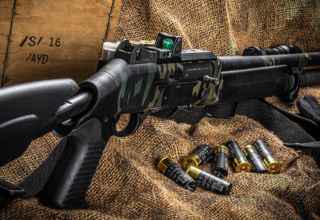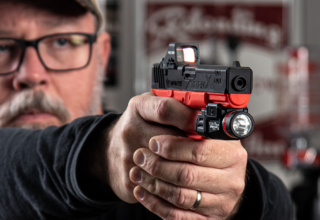In my younger years, I was naïve about the art of bear baiting. In fact, I didn’t consider it an art. I figured it to be as easy as trekking out into the wilderness, tossing some dog food on the ground and viola, bears would arrive in droves. How wrong I was.
It wasn’t until 2014, when I embarked on a DIY public-land bear adventure with my buddy and certified bear guru Jim Brennan, that I fully came to appreciate the process.
Idaho Public Land
“It’s a hike in,” Brennan told me as we loaded up packs and buckets with dog food, oil and the like. And what a hike it was. Up a long, winding steep embankment, across a small canyon, up the other side and out across a long ridge.
“This ridge has always been a good spot,” Jim told me as we eased out to the point. “You see how the ridge drops off on all sides?” he asked. “This allows the wind and thermals to pull the scent down into each of those deep, timbered canyons. Bears love deep canyons with adequate cover, and being that they can edge up the canyon and pop right out on the bait is a bonus.”
The bait crib — a v-shaped natural hole at the base of a big pine covered with logs had been ripped to sherds — pieces of food were strewn about. It was obvious a sizeable carnivore had been in the area.

“There are a few bears hitting here,” Jim told me. “They have a good pad trail coming up to the bait, and I’ve had a few different bears on camera.” Carefully and quietly, Jim dumped dog food into the hole, poured some oil over it and then placed oil on a few logs and the like. In addition, he pulled out a bottle of Boar Masters Bear-ly Legal Bear Spray in Raz-Donut flavor and sprayed the waterproof liquid on the trunks of a few trees as well as some other vegetation. It was a lot of work, but that night, I shot a pure chocolate boar.
Bear Progression
Since that first bear hunt in northern Idaho, I’ve been blessed to hunt a pair of Canadian provinces as well as a few other locales in the lower 48. Most recently, I was the guest of Brian Lewis, owner of Twisted Horn Outfitters.
 Side of hunting Crown Land in Canada, which is the equivalent of public land in the U.S., I’ve never hunted private dirt for bears. Yes, nonresidents must have a guide when hunting Crown Land, but we were sharing the ground with other Canadian bear hunters, which made the access non-exclusive.
Side of hunting Crown Land in Canada, which is the equivalent of public land in the U.S., I’ve never hunted private dirt for bears. Yes, nonresidents must have a guide when hunting Crown Land, but we were sharing the ground with other Canadian bear hunters, which made the access non-exclusive.
Brian and his team were big on bread products, and being the hunts took place on private land, opted to chain 50-gallon drum barrels to trees.
“We use a mix of oats and bread products,” Brian said. “The bears really like the bread. Over the course of the year, we collect lots of bread and then use a commercial trash compactor to press the bread down into 50-pound blocks. The blocks go in the barrels with the oats, and we cut a small hole in the bottom of the barrel. We place sticks and the like on top of the barrel and shove a sizable stick in the hole. When the sticks on top are gone and the stick in the hole has been pulled out, the bait has been hit. Having the small hole means the bears really have to work to get food out. This keeps them at the bait longer, and means we don’t have to re-bait as often. Not having to go in and bait all the time keeps human scent down. Barrels are a great option if you have access to private dirt.”
Go Deep! Go Big!
Marc Warnke has a serious big bear addiction. Side of that, he owns www.packgoats.com and www.topendadventrues.com. Though Marc is a hunting consultant and has guide/outfitter contacts all over the world, he prefers to hunt bruins on public dirt deep in the Idaho wilderness.

“Having my goats is critical,” Marc said. “Yes, you can use horses, mules and the like, but I prefer goats. The benefit of using animals of any sort is that you can haul massive loads of bait into the backcountry and get far off the beaten path.
 “My baiting focus is all about three factors: protein, carbohydrates and stink. You have to have all three. I use simple dog food for the protein. I buy the cheapest stuff I can find and stockpile it. When it comes to carbohydrates, I use a bagged pellet from a company called Master-Bait. The name is a little weird, I know, but it works so well. For my stink, which I really feel is the most important part, I use carp. Carp is not a game fish and can be used legally in many states. Just make sure to check game and fish regulations ahead of time. I don’t use the carp for food. Rather, I stuff it in a nylon-type garment or a pair of panty hoes and burry it my backyard. The longer you can bury it, the better. Just know when you pull it out of the ground, it’s going to wreak, but that’s a good thing. Hang the stink high in a tree and out on a limb a bear will be reluctant to go out on. I’ve been able to use the same carp for a few years in a row. It’s gross, but it works.”
“My baiting focus is all about three factors: protein, carbohydrates and stink. You have to have all three. I use simple dog food for the protein. I buy the cheapest stuff I can find and stockpile it. When it comes to carbohydrates, I use a bagged pellet from a company called Master-Bait. The name is a little weird, I know, but it works so well. For my stink, which I really feel is the most important part, I use carp. Carp is not a game fish and can be used legally in many states. Just make sure to check game and fish regulations ahead of time. I don’t use the carp for food. Rather, I stuff it in a nylon-type garment or a pair of panty hoes and burry it my backyard. The longer you can bury it, the better. Just know when you pull it out of the ground, it’s going to wreak, but that’s a good thing. Hang the stink high in a tree and out on a limb a bear will be reluctant to go out on. I’ve been able to use the same carp for a few years in a row. It’s gross, but it works.”
Sage advice from a trio of bear killers. Match their tips and tactics to meet the needs of your next bear sojourn and come out of the woods with a heavy hide and meat for the grill.
















